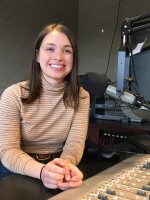A bill that would allow cyclists to yield through stop signs and intersections—when safe to do so—was given the green light at the House Transportation Committee hearing last week. KPCW’s Emily Means has more.
Rep. Carol Spackman Moss, a Democrat from Holladay, ran the same bill last year, but it was held up in the Senate on the last day of the session. This year’s House Bill 161 would allow a cyclist to approach a stop sign, yield the right of way to a vehicle, if there’s one there, and then proceed slowly through the intersection without stopping. At red lights, cyclists would first be required to stop, yield to any traffic and then go through the light. Moss says cyclists struggle with picking up speed after stopping at an intersection, and some of them have come to her after being cited for running the red lights even when there are no vehicles around. She says this same sort of law has been on the books in Idaho for decades.
Moss presented the bill with cyclist Jim Greene. Greene says he commutes 15 miles by bike to work each day and tries to stick to the smaller roadways. But when he comes to an intersection, Greene says it’s safer for him to go through when there are fewer cars around him, especially when many motorists don’t give him enough space to share the road.
"When I come up to a red light, I can stop at that light, and usually what happens is cars come also and stop at that light. By the time it turns green, I’m now having to share that intersection with many cars from both directions, turning, some of which may not see me," Greene said. "If, on the other hand, I can come up to that red light, stop, be sure that there’s no traffic coming the other way, and by the way, if there is traffic coming the other way, then it is safest to wait for the green, but if there’s an empty intersection it is much safer for me to proceed through that intersection without having to share it."
Jason Davis, deputy director at the Utah Department of Transportation, shared his concerns with the legislation. He clarified that stop lights don’t change because a sensor detects a particular weight, but that wires in the road detect a “magnetic difference,” and bikes don’t often have enough metal to trigger them. Davis says UDOT has updated sensors on heavily cycled roadways that more easily detect a presence at the intersection, and also that bicycle fatality numbers have dropped in the last six years. He was worried, though, that running red lights would result in even less awareness of cyclists by motorists.
"We already have the concerns that the bicyclists have that cars aren’t always seeing them, and they’re not even going to be looking for a bicyclist if they have a green light. They’re going to proceed through that intersection like no impediment will be there, no other obstruction will be traveling through that intersection if they have a green light," Davis said. "We already heard that bicyclists have to get up to speed, and I’d be concerned that maybe they’d misjudge how long it would take them to clear that intersection with a car coming very quickly, perhaps over a hill or just with all the other noise that happens with our intersections."
The bill passed out of committee on a 10-1 vote and will next be presented on the House floor. A similar bill, that would allow cars to go through stop lights during low traffic times, was held in committee for some adjustments.


